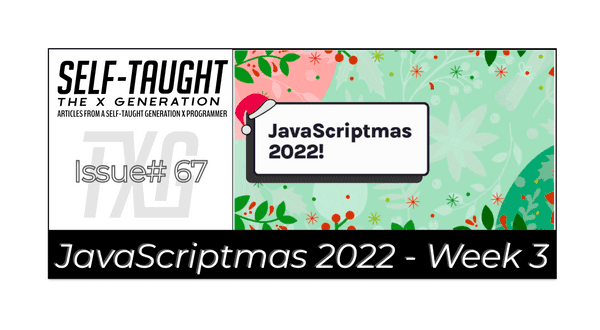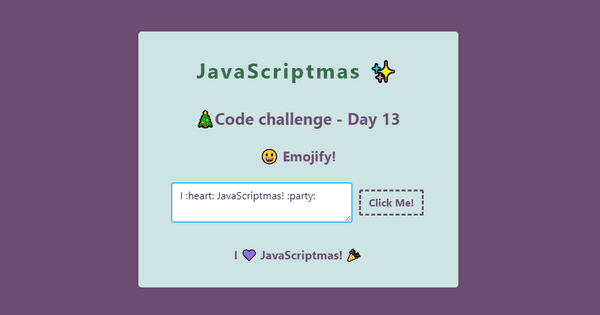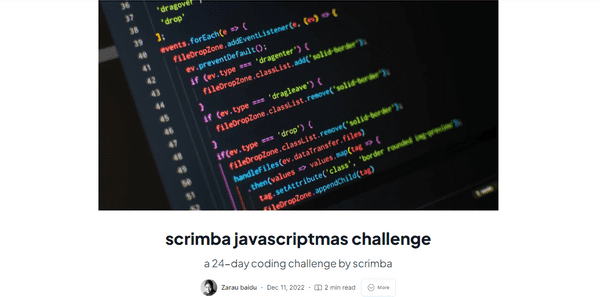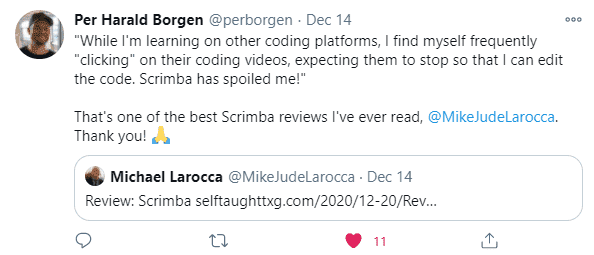JavaScriptmas 2022 - Issue 3
Published on December 19, 2022
JavaScriptmas is almost over, but there is still time to get in on the fun! I cover the event in this article series by completing each daily challenge, providing solutions, and featuring others' works!
Intro
Grab your favorite holiday drink, put on some festive music, and get ready to code! 🍹
JavaScriptmas is a 24-day coding challenge event where you can win prizes, regardless of your skill level, by submitting valid solutions and helping others by recording code reviews of their work. 🎄
In this article series, I'm completing each challenge and stepping through and documenting in detail how I solve each one. If you are new to coding or just curious about my solution approach, you may find it helpful for your code-learning journey! 💻
I will also be highlighting others' outstanding works as I come across them during this wonderful festive event! 🎉
Prize rules
From December 1st to the 24th, new coding challenges will be released daily. All valid solutions submitted in their Discord JavaScriptmas channel act as a raffle ticket. So the more valid solutions you enter, the more chances you have to win! Two winners will be drawn during their YouTube Livestream on December 24th and receive $1000 cash plus a lifetime Scrimba Pro membership!
The first winner will be chosen randomly from the daily coding challenge submissions (on Discord).
The second winner is randomly chosen from their submitted code reviews (on Discord). Each submitted coding review acts as a single raffle ticket, so the more you help others, the more chances you have to win a prize!
Note: You must enter each daily coding challenge submission by midnight (GMT), and it must be a working solution for your entry to be valid.
What are code reviews?
What are the code reviews? A code review is when YOU record a scrim reviewing another person's JavaScriptmas solution, providing constructive feedback.
For a deep-dive into learning how to create Scrimba screencasts, I wrote this detailed article on the topic: How to create Scrimba screencasts and turn them into a Scrimba course
Community highlights ⬇
Daniel Nagaoka
The day 17 challenge instructs us to write a function to flatten nested arrays of strings or numbers into a single array. Although there is a method for this, we are encouraged also solve it manually.
Unlike the many who solved this challenge with nested loops, including myself, Dan creatively solved it using recursion!
So, what is recursion? FreeCodeCamp describes, "recursion is when a function calls itself until someone stops it. It can be used instead of a loop. If no one stops it, it'll recurse forever and crash your program. A base case is a condition that stops the recursion."
My initial thought was to use recursion to solve a challenge like this, flattening arrays. However, I understand the theory of recursion, but I need to learn how to use it in practical application. So I was excited when I came across Dan's message in the JavaScriptmas Discord, along with a link to his elegant solution:
Initially, Dan only had a few lines of code (without the comments explaining the code). I reached out to Dan, complimenting his work, and I asked if he could please elaborate on his solution, as it will significantly benefit others learning to code, including myself!
Not only did he add comments to his solution, but Dan also took the time to write a whole article section! So, without further ado, let's learn from Dan on the topic of recursion ⬇
First, a few notes on the Array.prototype.reduce() method. It's not the main feature of the solution, but it can be quite a handful for beginners, so I'd rather address it, albeit briefly.
In short, the reduce method consolidates the original array into a single value - which can be virtually anything, from a string or number to a completely new array or an object. To do that, it iterates through its children and processes each of them with a custom function - the reducer callback function. The reducer will always receive data about the current iteration as arguments, the most important being:
- The consolidated (or "accumulated") value that will be expanded upon, then passed on to the next iteration;
- The current child being processed in this iteration.
The reduce method itself, therefore, requires:
- The reducer callback function, as described above;
- An initial state for the consolidated value.
For a hands-on explanation, you can refer to this really good video by Mosh.
Now for the actual usage of recursion.
Simply put, recursion is just a function that calls itself. That may summarize it, but its applicability can be a little more elusive to beginners.
Let's start by getting something out of the way: recursion !== looping. It isn't, and if you're using it for this purpose, then you're just building confusing code.
Recursion really shines when we need to iterate over a structure of interconnected elements (called nodes) which you need to process, sort or find something in it while having no previous knowledge about its size or depth - most often to perform complex operations that is likely to produce many branches during the execution. Stuff such as tree traversal, path finding and sorting algorithms are common scenarios where recursion is required.
So why does it apply in our current scenario? Let's say you were to flatten an array using a for loop:
function flatten(arr) {
const newArray = [];
for (const item of array) {
if (Array.isArray(item)) newArray.push(...item);
else newArray.push(item);
}
return newArray;
}
const array = [1, 2, [3, 4]];
// [1, 2, 3, 4];
console.log(flatten(array));Sure, that works, but try a different, more elaborate array structure. Let's say:
const ohnoes = [1, 2, [3, [4, 5]]];
// [1, 2, 3, [4, 5]]
console.log(flatten(ohnoes));You probably realized that it is utterly unsustainable to nest n for loops in your code to account for n possible layers.
Thinking recursively, though, is often a daunting task. Let's look at the problem a little closer:
- We want to flatten an array that is likely to have arrays as children;
- The child arrays, though, are not guaranteed to be flattened themselves.
You probably guessed that we now need to call the same function to micromanage each of the array's children as well. Considering that:
- The function should only ever reach its
returnexpression with a flattened array; - The recursion path will eventually hit the bottom node of the structure - an array without child arrays - and then return it.
All of these stacking function calls are appropriately referred to as the call stack. When our current stack finally resolves itself, we must expect the resulting array to be - ta-dah! Flat as 1 week old soda.
Now all that's left is putting together our recursive function:
function flattenRecursive(arr) {
// loop through the children to see which requires flattening
return arr.reduce(
(consolidated, child) => {
// check if the child is an array itself
if (Array.isArray(child)) {
// we need to flatten the array before including its elements in
// our consolidated array, so we call flattenRecursive recursively
consolidated.push(...flattenRecursive(child));
} else {
// not an array, so just include it in the final array
consolidated.push(child);
}
// return the consolidated array
return consolidated;
},
[], // the initial, empty array
);
}And now we get:
const yay = [1, 2, [3, [4, [5, [6, [[[[[7], [8, 9]]]]]]], 10]]];
// [1, 2, 3, 4, 5, 6, 7, 8, 9, 10]
console.log(flattenRecursive(yay));And that's about it!
Recursion is a bit too hefty a subject to tackle casually in an article like this and admittedly not something we really use often in our everyday lives as programmers. It is, however, a powerful technique when it comes into play, and definitely a must-have skill for every computer scientist.
- Dan
🎉Absolutely amazing! Thank you so much, Dan, for sharing your insights and providing us with this valuable content! 🎉
🔗 LinkedIn: Daniel Nagaoka
🔗 Link to Dan's challenge scrim: Pumpkin's Prizes
Carla
Carla Took the day 13 emoji challenge and turned it into a beautifully styled form that displays the messages entered by the users!
The challenge instructs us to write two functions. The first function replaces lowercase words surrounded by colons with a corresponding emoji. Then the second function finds any emoji shortcodes in a phrase.
const emojis = {
"smile": "😊",
"angry": "😠",
"party": "🎉",
"heart": "💜",
"cat": "🐱",
"dog": "🐕"
}As you can see in the picture above, when a user enters a phrase and clicks the "Click Me" button, corresponding emojis are replaced by words surrounded by colons. "I 💜 JavaScriptmas! 🎉"
Carla's Discord: carlamar#3910
Zarau baidu
Zarau solved the first day's JavaScriptmas challenge and wrote a detailed article covering it!
In Zarau's article, she introduces us to Scrimba's JavaScriptmas event. She then breaks down the explanation of the challenge with a nice bulleted list, a code block, and the hint provided by Scrimba to solve it.
Zarau then details her thought process in a paragraph that steps us through her approach to solving the challenge and then provides the JavaScript code she wrote.
My JavaScript code challenge solutions ⬇
Day 12 challenge
Breakfast Menu
Topic: .map() Our restaurant menu currently only shows the breakfast menu,as it has been hard coded into the HTML file. However, we want to offer a dinner menu instead. Let's fix this using .map()
- First, fetch a reference to the menu
from the DOM. - Set the innerHTML content of the menu
to... - the dinnerFoods array by mapping over the array and returning the following div for each food in the array:
<div class="food">FOOD VALUE HERE</div> - Remember to remove any separating commas between the food divs!
The challenge provides all the HTML and CSS. We just need to write the JavaScript.
First, we assign the menu variable using getElementById() as follows:
const menu = document.getElementById("menu");Now let's take a look at the HTML <div> the challenge asks us to create:
<div class="food">FOOD VALUE HERE</div>To solve the challenge, we will use map() as instructed, and we will use string interpolation to replace "FOOD VALUE HERE" for each item in the dinner foods array, using join() to remove the commas.
menu.innerHTML = dinnerFoods.map(item => `<div class="food">${item}</div>`).join('');Day 13 challenge
Emojify
1. Write a function that checks if a lowercase word starts and ends with a colon. If it does, remove the colons and look up the word in the emoji object. If the word is in the emojis object, return the corresponding emoji.If it isn't, return the original word.
2. Write a function to find any emoji shortcodes in a phrase.Your function should map over each word in the phrase, emojify any word that begins and ends with a colon, then return the emojified phrase.Feel free to use your emojify function from the previous exercise!
We solve this challenge by creating two functions. The first function returns an emoji if they pass certain conditions and if it exists in the emoji object. The second function returns a sentence and utilizes the first function to replace applicable words with emojis.
Function 1
Let's start with writing the first function. The challenge provides an emoji object. I created an emoji array by utilizing Object.entries() as follows:
const emojisArray = Object.entries(emojis);
console.log(emojisArray);
[["smile", "😊"], ["angry", "😠"], ["party", "🎉"], ["heart", "💜"], ["cat", "🐱"], ["dog", "🐕"]] Now, we need to determine whether the passed-in word starts and ends with a colon. We use an if statement, startsWith(), and endsWith().
if(word.startsWith(':') && word.endsWith(':')) {
}Next, we create a variable using slice() to remove the colons.
const wordSlice = word.slice(1,-1)Now, using a for loop, we iterate over the emoji array. If we find a matching word, we return the corresponding emoji. If we do not find a matching word, we return the wordSlice variable (returning the wordSlice variable filters out matches that begin with an UPPERCASE).
for(let i = 0; i < emojisArray.length; i++) {
if(wordSlice === emojisArray[i][0]) {
return emojisArray[i][1];
}
}
return wordSlice;Finally, we return the passed-in word If no conditions are met in the if statement.
return word; That was a lot to take in, so let's see the entire completed function.
function emojifyWord(word){
const emojisArray = Object.entries(emojis);
if(word.startsWith(':') && word.endsWith(':')) {
const wordSlice = word.slice(1,-1)
for(let i = 0; i < emojisArray.length; i++) {
if(wordSlice === emojisArray[i][0]) {
return emojisArray[i][1];
}
}
return wordSlice;
}
return word;
}Function 2
Now it's time to write the second function. This function will take in a string ( a sentence ) and replace any lowercase word that starts and ends with a colon and exists in the emoji array.
We start by turning that passed-in string into an array:
const phraseArray = phrase.split(' ');
console.log(phraseArray);
["I", ":heart:", "my", ":cat:"]Next, we write a for loop to iterate over the emoji array and use an if statement in search of lowercase words starting and ending with colons.
if(phraseArray[i].startsWith(':') && phraseArray[i].endsWith(':')) {
}If we find a lowercase word that starts and ends with a colon, we use the first function to retrieve the emoji, and then we use splice() to replace the word in the string with the emoji.
phraseArray.splice(i,1,emojifyWord(phraseArray[i]));Finally, we return the phrase array using join().
return phraseArray.join(' ');Here is the entire second function:
function emojifyPhrase(phrase){
const phraseArray = phrase.split(' ');
for(let i = 0; i < phraseArray.length; i++) {
if(phraseArray[i].startsWith(':') && phraseArray[i].endsWith(':')) {
phraseArray.splice(i,1,emojifyWord(phraseArray[i]));
}
}
return phraseArray.join(' ');
}
console.log(emojifyPhrase("I :heart: my :cat:"));
I 💜 my 🐱Day 14 challenge
Count Vowel Consonant
You are given string s that consists of only lowercase English letters. If vowels ('a', 'e', 'i', 'o', 'u') are given a value of 1 and consonants are given a value of 2, return the sum of all of the letters in the input string.
I solved this challenge using a for loop and an if statement. If the current letter in the loop is a vowel, I add 1; if the current letter in the loop is a consonant, I add 2. I return the total in a variable named counter.
function countVowelConsonant(str) {
let counter = 0;
for(let i = 0; i < str.length; i++) {
if(
str[i] === 'a' ||
str[i] === 'e' ||
str[i] === 'i' ||
str[i] === 'o' ||
str[i] === 'u'
){
counter++;
} else {
counter+=2;
}
}
return counter;
}Day 15 challenge
Palindromes
Palindromes are words that are the same forward or backward. For example, "noon" and "kayak" are palindromes.
Write a function to check if a lowercase string of letters is a palindrome. If the word is a palindrome, return true. If it isn't, return false.
We solve this challenge by comparing the string passed-in with the reversed version of the passed-in string. We use the JavaScript methods split, reverse, and join in accomplishing this task.
Let's take a look one step at a time:
We first use split()
const split = str.split('');
console.log(split);
["p", "u", "m", "p", "k", "i", "n", "s"]Then we use reverse()
const reverse = split.reverse();
console.log(reverse);
["s", "n", "i", "k", "p", "m", "u", "p"]Now we use join()
const join = reverse.join('');
console.log(join);
snikpmupWe can clearly see that the word "pumpkins" is not the same when reversed.
To solve the challenge, we can use the Conditional (Ternary) Operator to write one succinct line of code to add to the function as follows:
function isPalindrome(str){
return str === str.split('').reverse().join('') ? true : false;
}Day 16 challenge
Insert Dashes
Transform a given sentence into a new one with dashes between each two consecutive letters.
Example For inputString = "aba caba" the output should be "a-b-a c-a-b-a"
Hints
- join()
- split()
At first glance, this challenge seems like it will be solved by simply using join() and split(). However, doing so results in extra dashes, failing the challenge.
console.log(arr.split('').join('-'));
a-b-a- -c-a-b-aAlthough my approach to solving it is not succinct code, it is easy to follow logically.
Using a for each loop(), I pass each letter through an else if statement that covers all scenarios. I then push each appropriately modified letter into a new array that I join() and return.
Scenarios:
- The next item is blank
- The current item is blank
- The current item is the last in the array
function insertDashes(arr) {
const returnArray = [];
const splitArray = arr.split('');
for(let i = 0; i < splitArray.length; i++) {
if(splitArray[i+1] == " ") {
returnArray.push(`${splitArray[i]}`);
} else if (splitArray[i] == " "){
returnArray.push(`${splitArray[i]}`);
} else if(i === splitArray.length -1){
returnArray.push(`${splitArray[i]}`);
} else {
returnArray.push(`${splitArray[i]}-`);
}
}
return returnArray.join('');
}
result: ,"a-b-a c-a-b-a"Day 17 challenge
Pumpkin's Prizes
Scrimba mascot Pumpkin has won the grand prize at an international cat show. Below are Pumpkin's scores from the judges, as well as all the prizes he's won. In all the excitement of victory, they've become a jumbled mess of nested arrays. Let's help Pumpkin by sorting it out.
Write a function to flatten nested arrays of strings or numbers into a single array. There's a method for this, but pratice both doing it manually and using the method.
Example input: [1, [4,5], [4,7,6,4], 3, 5] Example output: [1, 4, 5, 4, 7, 6, 4, 3, 5]
This challenge was a tricky one, to say the least. Although there is a method to flatten arrays, they ask to devise a manual solution.
So I took the approach of checking the length of each item in the array. If the item was a length of 1, push it into a new array to return. If the value is greater than 1, start a new loop and push all of the values into the same new array to return.
However, I ran into several interesting issues. The length of a single number is "undefined." So to resolve this issue, I check if the current value type is equal to "undefined," and if it is, then it is a single number to push into the return array.
if(arr[i].length === undefined) {
}Now, I was able to pass the challenge by checking if the type is equal to "undefined" on each item in a nested loop. That is, of course, until I tried to pass in an array of emojis.
Did you know that the length of an emoji is 2? Actually, JavaScript misinterprets an emoji length as 2.
So then, what is an emojis type of value? It's a string! So now I check if the current items in a loop are equal to a string.
typeof arr[i] === "string"So, does my updated code help me pass the challenge? Almost.
The nested arrays have a type of value of "object." However, remember, I'm getting an "undefined" type of value for single numbers. To resolve this issue and to finally solve the challenge, I check for both as follows:
if(arr[i].length !== undefined && typeof arr[i] === "object") {
}Here is a code block of my final code challenge solution.
function flatten(arr){
const arrayFlattened = [];
for(let i = 0; i < arr.length; i++) {
if(arr[i].length === undefined || typeof arr[i] === "string") {
arrayFlattened.push(arr[i])
}
for(let r = 0; r < arr[i].length; r++) {
if(arr[i].length !== undefined && typeof arr[i] === "object") {
arrayFlattened.push(arr[i][r]);
}
}
}
return arrayFlattened;
}Note: For this type of challenge, dealing with flattening nested arrays, I advise using recursion as a solution. Be sure to check out Dan's recursion section in this article!
Day 18 challenge
Candies
n children have got m pieces of candy. They want to each as much candy as they can, but each child must eat exactly the same amount of candy as any other child. Determine how many pieces of candy will be eaten by all the children together. Individule pieces of candy cannot be split.
Example
For n = 3 and m = 10, the output should be candies (n,m) = 9. Each child will eat 3 pieces. So the answer is 9.
Hints
Math.floor()
This challenge is solved easily using logical math. We take the total amount of candy and divide it by the children, then multiply it by the number of children. We use Math.floor() to eliminate any remainder.
function candies(children, candy) {
return Math.floor(candy / children) * children;
}If you would like to learn more about my journey with Scrimba and how learning with them may help you, you can read my article: How Scrimba is helping me and many others to become confident, well-prepared web developers
I continue to have wonderful experiences with Scrimba, and I highly recommend learning with them! You can read my full Scrimba review on my 12/13/2020 post.
"That's one of the best Scrimba reviews I've ever read, @MikeJudeLarocca. Thank you! 🙏 "
— Per Harald Borgen, CEO of Scrimba December 14, 2020
Advance your career with a 20% discount on Scrimba Pro using this affiliate link!
Become a hireable developer with Scrimba Pro! Discover a world of coding knowledge with full access to all courses, hands-on projects, and a vibrant community. You can read my article to learn more about my exceptional experiences with Scrimba and how it helps many become confident, well-prepared web developers!
Important: This discount is for new accounts only. If a higher discount is currently available, it will be applied automatically.
How to Claim Your Discount:
- Click the link to explore the new Scrimba 2.0.
- Create a new account.
- Upgrade to Pro; the 20% discount will automatically apply.
Disclosure: This article contains affiliate links. I will earn a commission from any purchases made through these links at no extra cost to you. Your support helps me continue creating valuable content. Thank you!
Conclusion
Scrimba's JavaScriptmas annual FREE event is a wonderful way to commit to coding daily. It is a fun and festive event where all participants have an equal opportunity to win prizes, regardless of their skill level.
By completing all 24 coding challenges and submitting them daily by midnight (GMT) time, each submission acts as a raffle ticket, so you will have up to 24 chances to win prizes, plus unlimited more chances with submitting coding reviews!
Let's connect! I'm active on LinkedIn and Twitter.
Are you now interested in participating in this year's Scrimba's JavaScriptmas? Have you already participated in last year's Scrimba's JavaScriptmas? Please share the article and comment!
Please share it!






